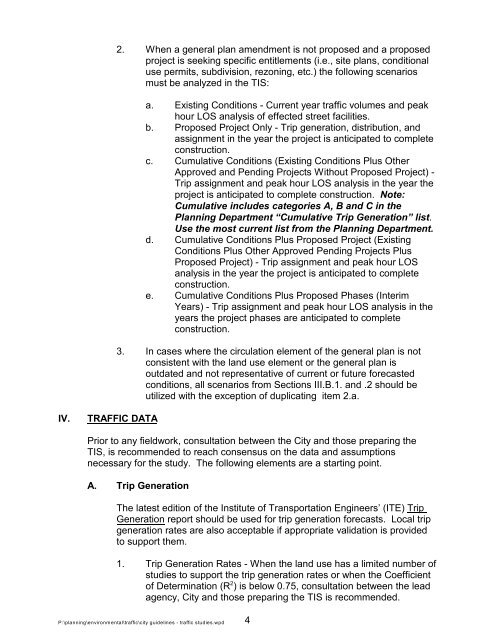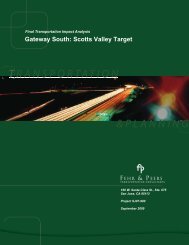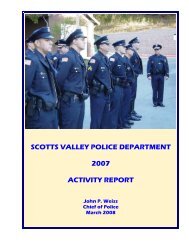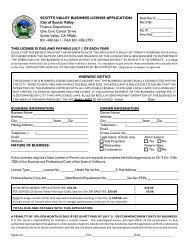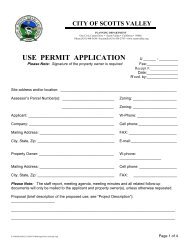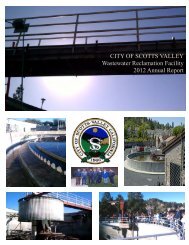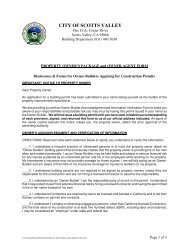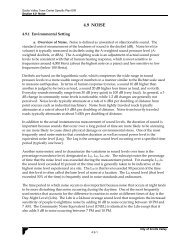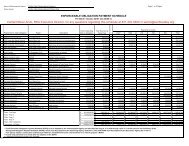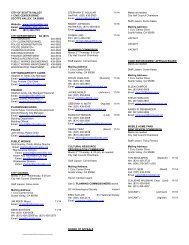Guide to Traffic Impact Study - City of Scotts Valley
Guide to Traffic Impact Study - City of Scotts Valley
Guide to Traffic Impact Study - City of Scotts Valley
You also want an ePaper? Increase the reach of your titles
YUMPU automatically turns print PDFs into web optimized ePapers that Google loves.
2. When a general plan amendment is not proposed and a proposed<br />
project is seeking specific entitlements (i.e., site plans, conditional<br />
use permits, subdivision, rezoning, etc.) the following scenarios<br />
must be analyzed in the TIS:<br />
a. Existing Conditions - Current year traffic volumes and peak<br />
hour LOS analysis <strong>of</strong> effected street facilities.<br />
b. Proposed Project Only - Trip generation, distribution, and<br />
assignment in the year the project is anticipated <strong>to</strong> complete<br />
construction.<br />
c. Cumulative Conditions (Existing Conditions Plus Other<br />
Approved and Pending Projects Without Proposed Project) -<br />
Trip assignment and peak hour LOS analysis in the year the<br />
project is anticipated <strong>to</strong> complete construction. Note:<br />
Cumulative includes categories A, B and C in the<br />
Planning Department “Cumulative Trip Generation” list.<br />
Use the most current list from the Planning Department.<br />
d. Cumulative Conditions Plus Proposed Project (Existing<br />
Conditions Plus Other Approved Pending Projects Plus<br />
Proposed Project) - Trip assignment and peak hour LOS<br />
analysis in the year the project is anticipated <strong>to</strong> complete<br />
construction.<br />
e. Cumulative Conditions Plus Proposed Phases (Interim<br />
Years) - Trip assignment and peak hour LOS analysis in the<br />
years the project phases are anticipated <strong>to</strong> complete<br />
construction.<br />
3. In cases where the circulation element <strong>of</strong> the general plan is not<br />
consistent with the land use element or the general plan is<br />
outdated and not representative <strong>of</strong> current or future forecasted<br />
conditions, all scenarios from Sections III.B.1. and .2 should be<br />
utilized with the exception <strong>of</strong> duplicating item 2.a.<br />
IV.<br />
TRAFFIC DATA<br />
Prior <strong>to</strong> any fieldwork, consultation between the <strong>City</strong> and those preparing the<br />
TIS, is recommended <strong>to</strong> reach consensus on the data and assumptions<br />
necessary for the study. The following elements are a starting point.<br />
A. Trip Generation<br />
The latest edition <strong>of</strong> the Institute <strong>of</strong> Transportation Engineers’ (ITE) Trip<br />
Generation report should be used for trip generation forecasts. Local trip<br />
generation rates are also acceptable if appropriate validation is provided<br />
<strong>to</strong> support them.<br />
1. Trip Generation Rates - When the land use has a limited number <strong>of</strong><br />
studies <strong>to</strong> support the trip generation rates or when the Coefficient<br />
2<br />
<strong>of</strong> Determination (R ) is below 0.75, consultation between the lead<br />
agency, <strong>City</strong> and those preparing the TIS is recommended.<br />
P:\planning\environmental\traffic\city guidelines - traffic studies.wpd<br />
4


